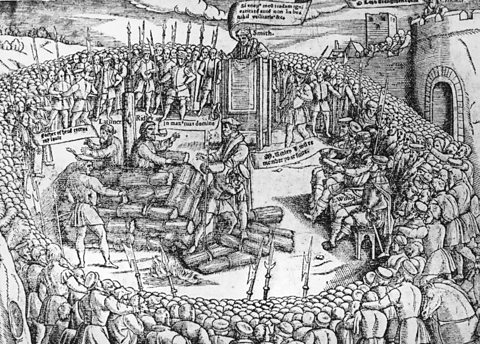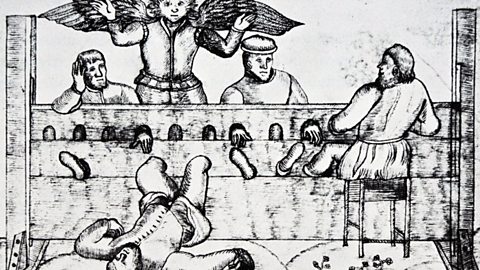Attitudes in the 16th and 17th centuries
Retribution
Retribution means to give an equivalent or returned punishment for a crime. It suggests a victim taking vengeanceTo get revenge. for a crime by making the criminal suffer. The desire for retribution was a key purpose for punishment until the early 19th century.
This was a key attitude behind capital and corporal punishment from the 16th to the 19th centuries and led to different punishments for different types of crime. All punishments gave retribution as criminals were made to suffer pain, humiliation and often death for their crimes.
Deterrence
Deterrence means to discourage someone from doing a crime by making them afraid of the consequences. This is usually done by making the punishment harsh and unpleasant.
Punishment
Retribution and deterrence were the main attitudes towards punishment in the 16th and 17th centuries. They led to harsh punishments where the criminals suffered pain, humiliation or death.
Capital punishment
Serious crimes in Tudor and Stuart times were punished with capital punishment. The most common method of execution was by hanging. Hanging would lead to death by strangulation, which often took several minutes.
Other methods of execution included burning at the stake, which was the punishment for heresy.

The method of execution for the crime of treason was beheading or hanging, drawing and quartering. Royalty were beheaded, usually with an axe. The traitorâs lands and money would be confiscated by the monarch.
In the 16th and 17th centuries, people supported capital punishment as it fulfilled their desire for retribution, and also served as a deterrent to others.
Corporal punishment

Several methods of corporal punishment were also used in the 16th and 17th centuries. The stocks and pillory were commonly used to humiliate and inflict pain on convicts. floggingA punishment that involves a public beating, usually with a flexible stick. was also used. Earlier in the period, mutilateTo disfigure or remove parts of a body. and brandingMarking a personâs skin with a hot iron. Vagrants were branded with a letter V for example. were also used.
Women who were said to scold or argue with their husbands were often punished with a ducking stool in a local river or pond, or led around the town wearing a Scold's Bridle â a heavy iron cage for the head with a tongue iron in the mouth. The different punishment for women reflects the attitudes towards, and status of, women in the early modern period.
These methods of capital and corporal punishment show the desire in Tudor and Stuart times to make punishments brutally harsh to act as both a deterrent and provide retribution.